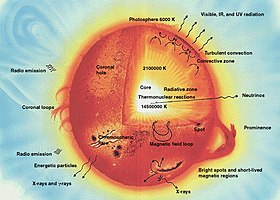Portal:Stars/Selected article/13

Stars of different mass and age have varying internal structures. Stellar structure models describe the internal structure of a star in detail and make detailed predictions about the luminosity, the color and the future evolution of the star. Different layers of the stars transport heat up and outwards in different ways, primarily convection and radiative transfer, but thermal conduction is important in white dwarfs. The internal structure of a main sequence star depends upon the mass of the star.
In solar mass stars (0.3–1.5 solar masses), including the Sun, hydrogen-to-helium fusion occurs primarily via proton-proton chains, which do not establish a steep temperature gradient. Thus, radiation dominates in the inner portion of solar mass stars. The outer portion of solar mass stars is cool enough that hydrogen is neutral and thus opaque to ultraviolet photons, so convection dominates. Therefore, solar mass stars have radiative cores with convective envelopes in the outer portion of the star. In massive stars (greater than about 1.5 solar masses), the core temperature is above about 1.8×107 K, so hydrogen-to-helium fusion occurs primarily via the CNO cycle. In the CNO cycle, the energy generation rate scales as the temperature to the 17th power, whereas the rate scales as the temperature to the 4th power in the proton-proton chains. Due to the strong temperature sensitivity of the CNO cycle, the temperature gradient in the inner portion of the star is steep enough to make the core convective.
The simplest commonly used model of stellar structure is the spherically symmetric quasi-static model, which assumes that a star is in a steady state and that it is spherically symmetric. It contains four basic first-order differential equations: two represent how matter and pressure vary with radius; two represent how temperature and luminosity vary with radius.
